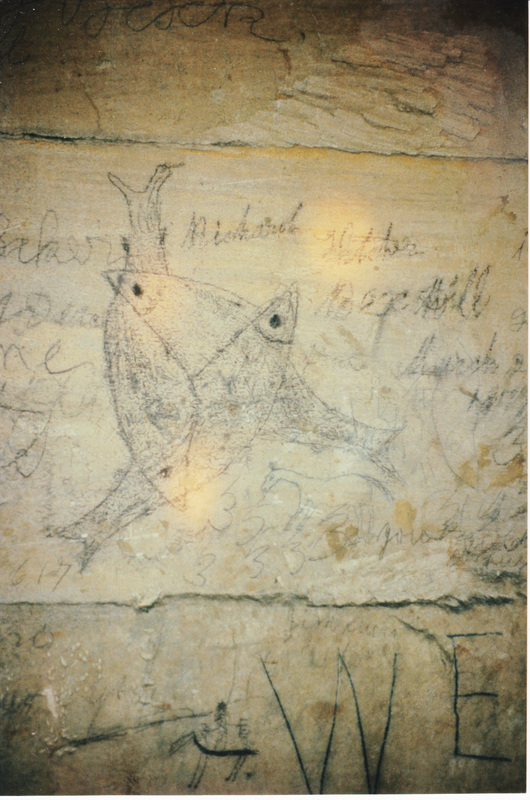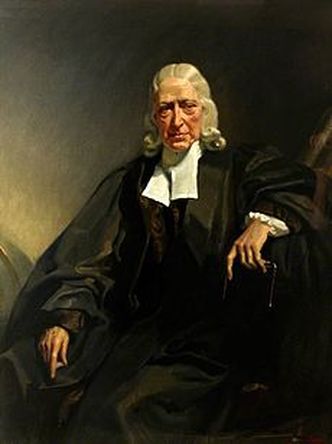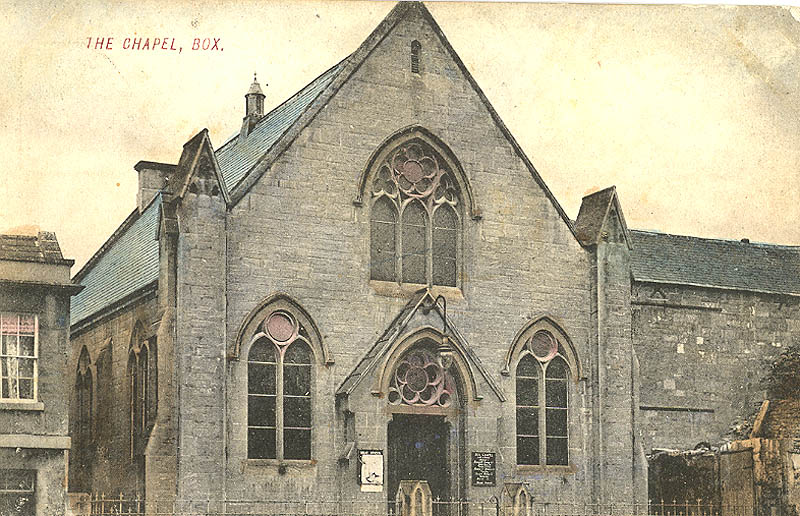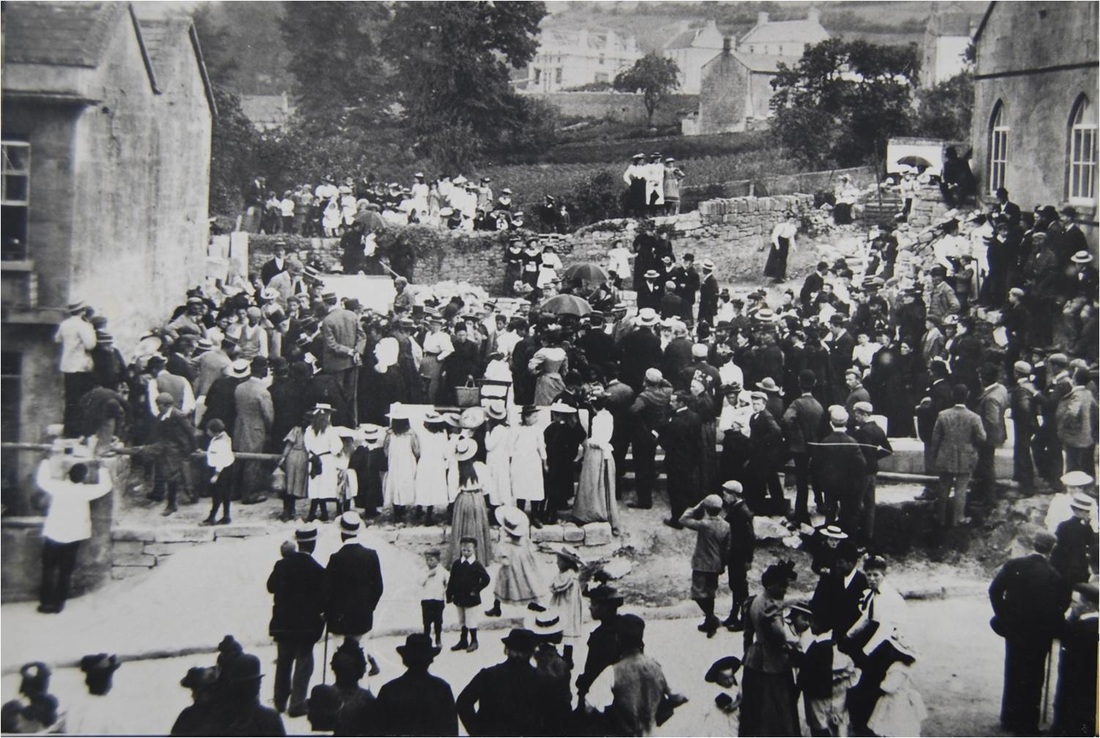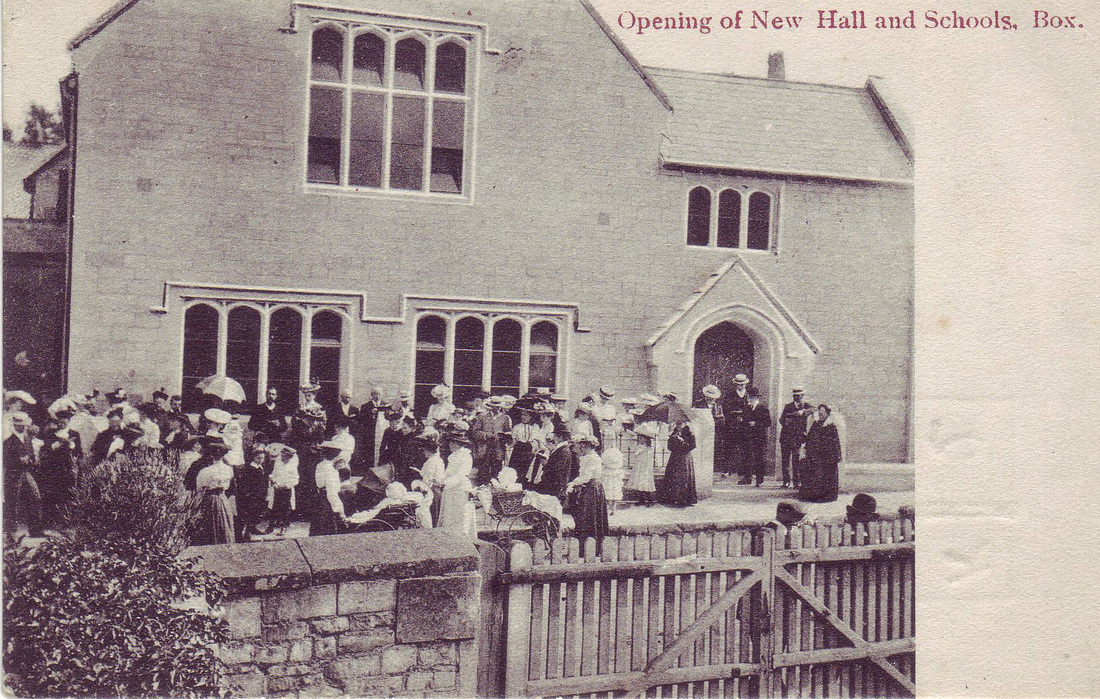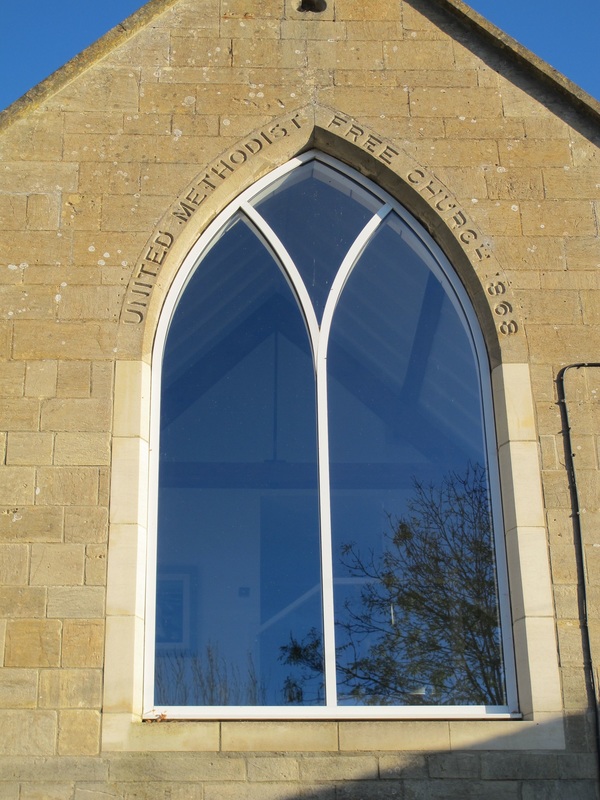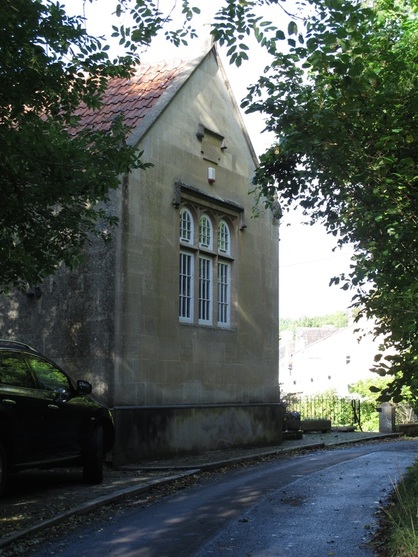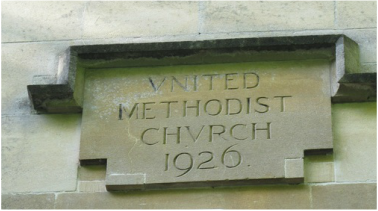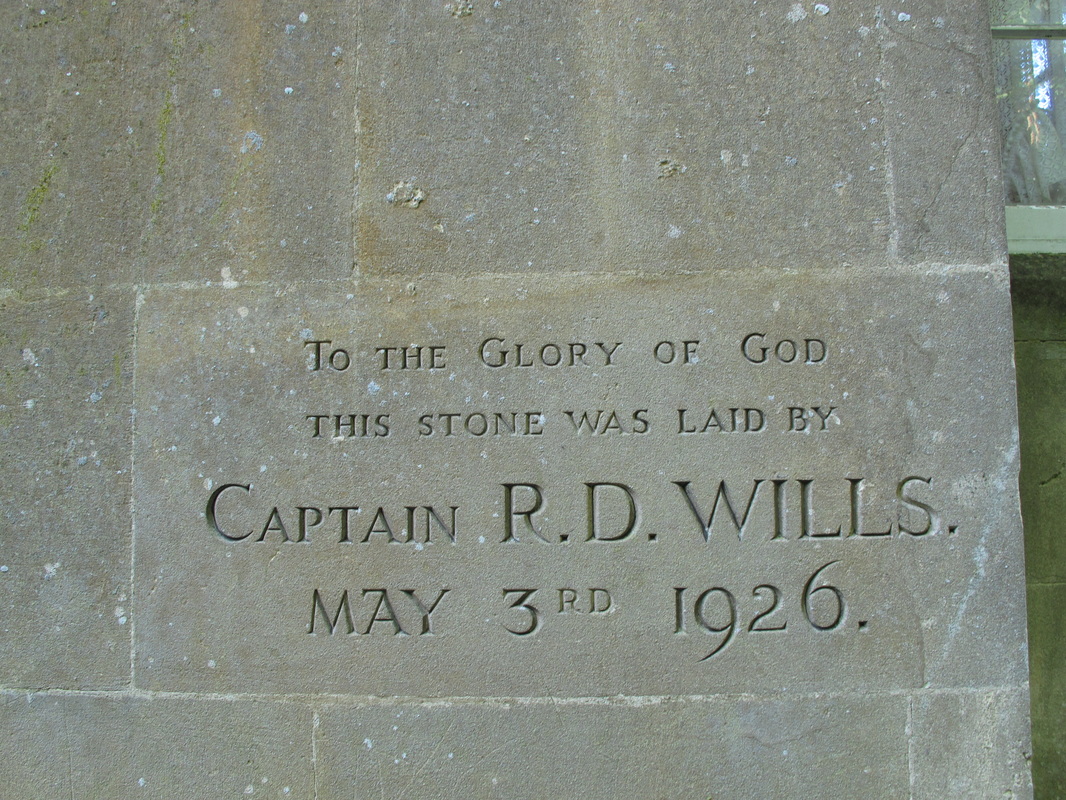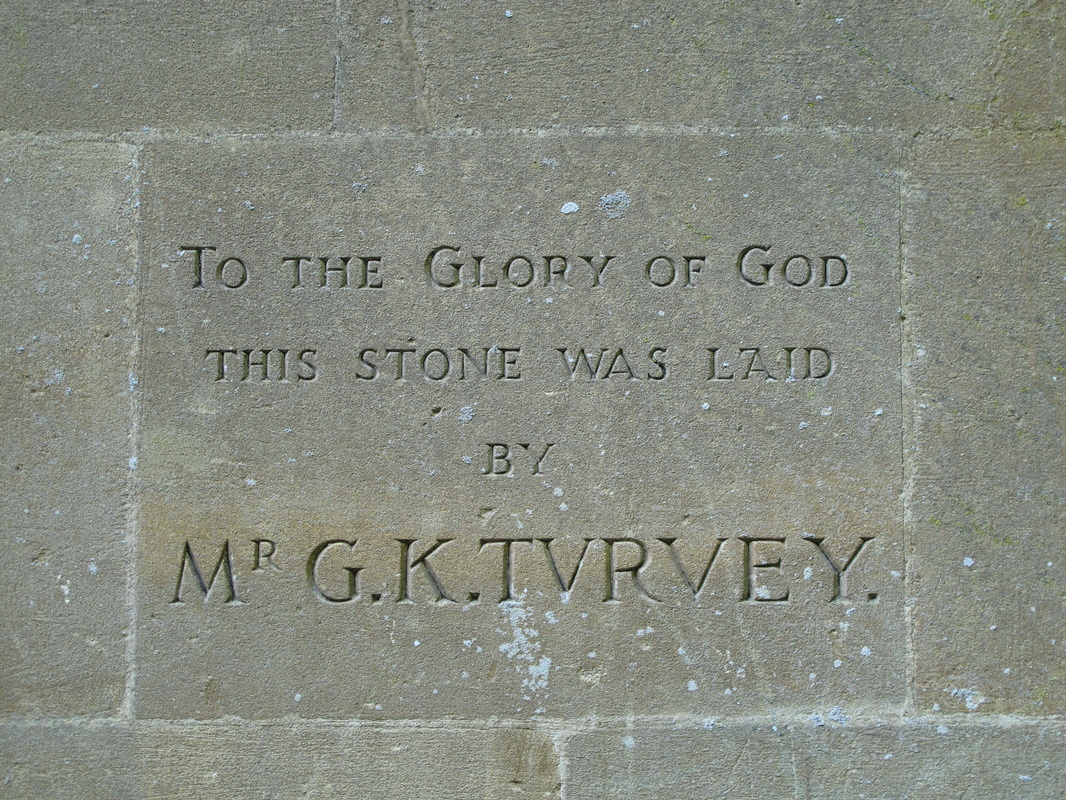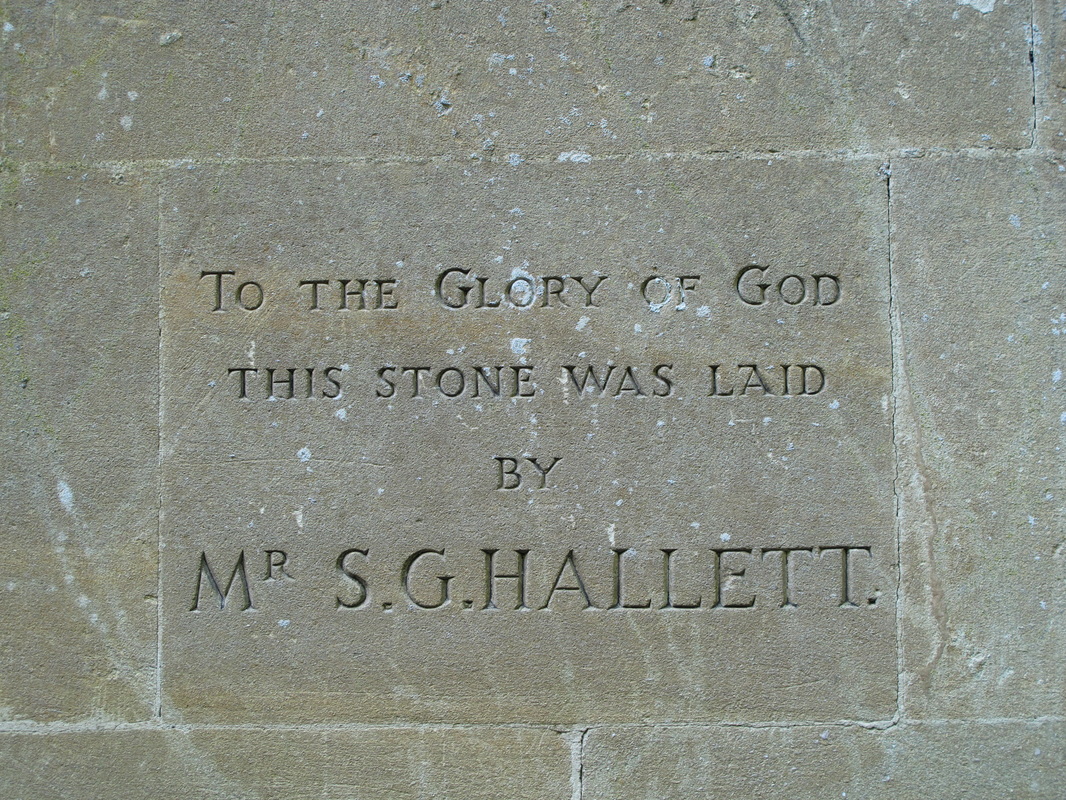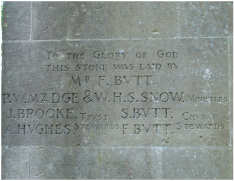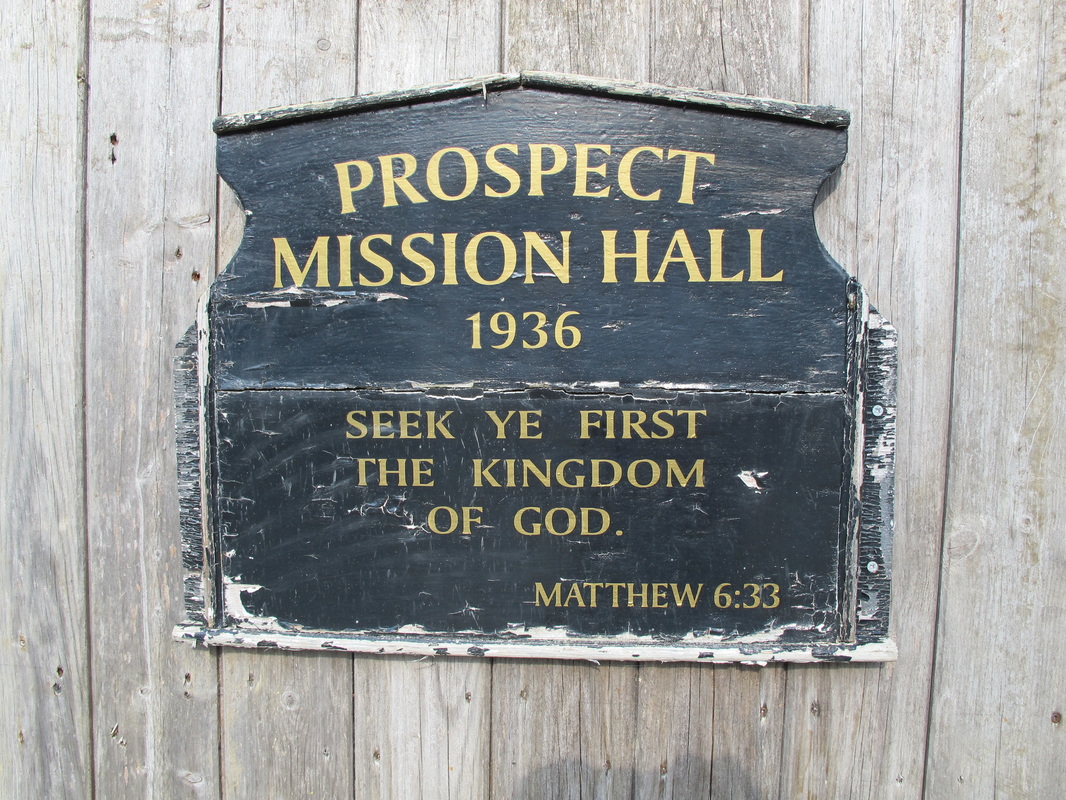|
Rise of Methodism in Box Alan Payne October 2015 One of the most remarkable developments of the late Victorian period was the rise of Methodism throughout England. In the face of a shift towards Anglo-Catholicism in the Established Church after the Oxford Movement of the 1830s and 1840s, the Methodist Movement separated from the Church of England and set up an alternative structure after 1844. Left: Sixtieth Anniversary in Box (courtesy http://boxmethodist.org/) |
|
Theological Basis
This article looks at the social consequences of Methodism but it is impossible to ignore the religious background which inspired it. The enthusiasm of the movement was infectious fired by articulate preachers. Central to their message was justification by faith alone, that God can redeem true believers regardless of the predestination of the Calvinist church or the actions required in Catholicism. Hence the possibility of salvation for all through God's Grace, even the redemption of murderers. It was a belief which attracted all classes in Box's society. It was clearly attractive to local working class people who often had insufficient money to do good works. The stone quarrymen who moved in to excavate the stone after the construction of Box Tunnel were very different people. They were very hierarchical, usually worked in family gangs (self-employed groups of relatives working on piece-rates), some were highly skilled pickers using long-handle picks to prise open the stone seams. Often they were highly paid, earning double, triple or even four times the wages of a farm labourer and the well-built cottages on Box Hill reflect their growing status.[1] The graffiti on the walls of the underground quarries reflect their religious commitment to Methodism and dissenting beliefs, full of Old Testament extracts. |
|
Early Methodism in Box
The area around Box had a long tradition of Methodism in the years before John Wesley's death in 1791 when, as part of his tour of Britain, he held several missions in Wiltshire at Bradford-on-Avon, Trowbridge, East Tytherton (near Chippenham) and Seend.[2] The Independent Calvinist preacher, Cornelius Winter (1742 - 1808), took up the local initiative, preaching with simple faith and great enthusiasm in the open air, targeting farm labourers and low-skilled workers like quarrymen.[3] Often the preacher spoke from dawn to dusk to those who cared to listen. If there was enough interest, nonconformist meetings were organised in the private dwelling houses of supporters. In 1802 a house belonging to Jacob Ford was certificated (authorised) at Middlehill.[4] |
The Rowe family (also called Roe) led the way to a permanent Methodist church in Box. In April 1820 the house of Samuel Rowe (probably the cottage Woodstock in Mill Lane) was certificated (registered for non-conformist worship).[5] This was followed in June 1825 when the property of Mr. James Rawlings was certificated at Box and in 1828 a dwelling house at Wadswick belonging to Peter Doorey.[6]
Conflict with Established Church
The newcomers were still unpopular in the middle of Box so they built their own Methodist chapels close to their newly constructed hamlets in the area.[7]
The wealth of the established church in Box was enormous in the Georgian and early Victorian times, based on personal acquisitions by proprietary parsons. The Rev Isaac Horlock built the present Box House in 1810 as the vicarage in the grounds of the Old Parsonage, which were large enough for Horlock to keep a menagerie in the gardens.[8] The property was so grand that when Dr Horlock sold the advowsen of Box Church in 1874, they retained Box House. For the new priest Dr Horlock bought another property, The Vicarage, Mead Villa, a mid 1800s house. The house has remained the vicarage until the present day.
Social conflict in mid Victorian Box included a fundamental difference in religious opinion between the Established Church and the rapidly growing Methodist movement. At times it was open warfare, as when the Rev Dr Horlock arrested a Methodist minister who was preaching outside his allotted area, to quarrymen on chapel ground at Spring Quarry.[9] The Church of England was perceived as the church of middle class conformity and wealth, which left an opening for the nonconformist movement to appeal to Box’s labouring classes as depicted by Wesley’s hymn, Our Saviour by the rich unknown, Is worshipped by the poor alone. The chapel movement with tightly-knitted congregations and inspirational fervour appealed to communities of quarry workers seeking to better their standards and wanting a solace to the hardship of their working lives.
The movement had many important supporters, particularly among some quarry owners. It stressed the importance of hard work and self-discipline characterised by Samuel Smiles' 1859 book Self-Help, which starts Heaven helps those who help themselves. The nonconformist movement took a stand against the excesses of the alcohol and improper behaviour and forced the hands of the quarry owners to authorise meetings on their premises. The Pictors were prominent Methodists in Box, proud of their religious beliefs and connected to other similar families in Box. Elizabeth Pictor, the fourth daughter of Job Pictor, married Samuel Rowe Noble in 1864.[10] Samuel Rowe Noble (possibly related to the owner of the dissenting house referred to above) was a small-scale quarrymaster, baker and farmer, referred to in a notice of 1870:[11]
The newcomers were still unpopular in the middle of Box so they built their own Methodist chapels close to their newly constructed hamlets in the area.[7]
The wealth of the established church in Box was enormous in the Georgian and early Victorian times, based on personal acquisitions by proprietary parsons. The Rev Isaac Horlock built the present Box House in 1810 as the vicarage in the grounds of the Old Parsonage, which were large enough for Horlock to keep a menagerie in the gardens.[8] The property was so grand that when Dr Horlock sold the advowsen of Box Church in 1874, they retained Box House. For the new priest Dr Horlock bought another property, The Vicarage, Mead Villa, a mid 1800s house. The house has remained the vicarage until the present day.
Social conflict in mid Victorian Box included a fundamental difference in religious opinion between the Established Church and the rapidly growing Methodist movement. At times it was open warfare, as when the Rev Dr Horlock arrested a Methodist minister who was preaching outside his allotted area, to quarrymen on chapel ground at Spring Quarry.[9] The Church of England was perceived as the church of middle class conformity and wealth, which left an opening for the nonconformist movement to appeal to Box’s labouring classes as depicted by Wesley’s hymn, Our Saviour by the rich unknown, Is worshipped by the poor alone. The chapel movement with tightly-knitted congregations and inspirational fervour appealed to communities of quarry workers seeking to better their standards and wanting a solace to the hardship of their working lives.
The movement had many important supporters, particularly among some quarry owners. It stressed the importance of hard work and self-discipline characterised by Samuel Smiles' 1859 book Self-Help, which starts Heaven helps those who help themselves. The nonconformist movement took a stand against the excesses of the alcohol and improper behaviour and forced the hands of the quarry owners to authorise meetings on their premises. The Pictors were prominent Methodists in Box, proud of their religious beliefs and connected to other similar families in Box. Elizabeth Pictor, the fourth daughter of Job Pictor, married Samuel Rowe Noble in 1864.[10] Samuel Rowe Noble (possibly related to the owner of the dissenting house referred to above) was a small-scale quarrymaster, baker and farmer, referred to in a notice of 1870:[11]
|
A BAZAAR in aid of the Building Fund of the NEW CHAPEL on Box Hill, will be held on TUESDAY, June 28th, 1870 in FOGLEIGH BARN, situate about five minutes walk from the village of Box, on the Chippenham Road (kindly lent for the purpose by Mr SR Noble).
In aid of the same object Messrs Pictor and Sons have kindly placed at the disposal of the Committee the use of their Locomotive and a few Carriages fitted up for the occasion to take visitors through their extensive Quarry Workings, thus affording an excellent opportunity for exploring the same. Trains will commence running at 1 pm, and will leave the entrance of the quarries every twenty minutes. THE BAZAAR WILL OPEN AT 12 am. Tickets 3d. Tickets for the Quarry Excursion, 1st Class, 6d; 2nd Class 3d. Refreshments can be ordered at the Bazaar. Last train from Box starts at 7.45 pm. |
There is a popular story of Robert Pictor permitting one of the galleries in Spring Quarry to be used for religious meetings. This quarry is still known as Chapel Ground.[12] The date of this isn't known but it may relate to the sudden death of Mr Pictor senior, the senior partner of the well-know quarry masters who went for a walk from his house in Box and dropped dead of a heart attack walking along the Corsham to Bradford-on-Avon road.[13]
1834 Methodist Church in Box
These early private meeting houses were completely overtaken by the extraordinary amount of chapel building between 1800 and 1850 in Wiltshire where nearly 1,200 dissenting churches were established. In Box, the Rowe family (Samuel, Thomas and Catherine) and the Noble family (Thomas and Samuel) applied for certification of a Chapel in our possession [14], the Ebenezer Methodist Chapel on 3 March 1834.[15]
A contemporary newspaper report confirms how much the chapel was indebted to the Noble family: a new Methodist chapel was opened for Divine service at Box. The chapel was erected at the sole expense of Mr Noble of Ashley and also on his own land.[16]
The chapel was probably situated on the site of the later schoolroom (now called Ebenezer Chapel) possibly accessed by a track off Chapel Lane.
1834 Methodist Church in Box
These early private meeting houses were completely overtaken by the extraordinary amount of chapel building between 1800 and 1850 in Wiltshire where nearly 1,200 dissenting churches were established. In Box, the Rowe family (Samuel, Thomas and Catherine) and the Noble family (Thomas and Samuel) applied for certification of a Chapel in our possession [14], the Ebenezer Methodist Chapel on 3 March 1834.[15]
A contemporary newspaper report confirms how much the chapel was indebted to the Noble family: a new Methodist chapel was opened for Divine service at Box. The chapel was erected at the sole expense of Mr Noble of Ashley and also on his own land.[16]
The chapel was probably situated on the site of the later schoolroom (now called Ebenezer Chapel) possibly accessed by a track off Chapel Lane.
|
New Methodist Church, 1897, and School, 1905
In the centre of Box, the size of the Ebenezer Chapel proved to be inadequate and had to be replaced. By the end of the century this early chapel was too small to accommodate its growing membership. They acquired land next to the Chapel fronting the London Road and built a new Church in 1897. Donations included the land reputed to have been given by the Pictor family. The labour to build the church was mainly free, much undertaken by members of the congregation, using stone manhandled in trucks down Quarry Hill, from Box quarries. |
The present Methodist Church was built of stone from Box Hill quarry and opened on 6 February 1897 by Lady Dickson-Poynder, wife of the Chippenham MP.[17] It was a grand occasion attended by Mr & Mrs Fuller of Neston Park with speeches showing a high spiritual tone and much fervour. The building cost £1,200 of which only £500 had been raised and the debt was a burden for many years, ultimately being funded by a loan from the Connexional Chapel Fund. The Methodist Hall and school classrooms were built in 1907.
Before the 1870 Education Act, dissenting children could not attend the charity school in Box unless they accepted orthodox Anglican teaching and Methodist Sunday School and Weekday Schooling was provided in an informal way in Box. In 1905 the original chapel and the cottages in front of it were demolished to build a brand new Methodist School. A wall of the original Chapel still remains at the back of the building. The cost of the school was a considerable burden on the congregation of the church who were obliged to incur a substantial debt and owed money on the building until the mid 1920s. They were obliged to take out additional loans which were only cleared after the 1932 Union of the Methodist movement.
Outreach Chapels, Box Hill and Kingsdown
Catering for small local congregations and reflecting changes in the location of new houses, four Methodist chapels were built in the hamlets of Box, two in the years 1868 and 1869. They were at Beech Road; at Box Hill close to the Quarryman's public house; at Longsplatt; and at Kingsdown. At times they were listed as: Box Methodist Church, High Street; Free Methodist Chapel (probably Box Hill); Plymouth Brethren Gospel Hall, Quarry Hill; and the Methodist Chapel, Kingsdown.[18]
Catering for small local congregations and reflecting changes in the location of new houses, four Methodist chapels were built in the hamlets of Box, two in the years 1868 and 1869. They were at Beech Road; at Box Hill close to the Quarryman's public house; at Longsplatt; and at Kingsdown. At times they were listed as: Box Methodist Church, High Street; Free Methodist Chapel (probably Box Hill); Plymouth Brethren Gospel Hall, Quarry Hill; and the Methodist Chapel, Kingsdown.[18]
|
Box Hill Chapel
Religious services had been held at Box Hill for a number of years in a cottage on the hill but this was inadequate and upon every favourable opportunity the service has been held on the open down.[19] Robert Pictor donated a plot of ground large enough for a chapel, school and vestries and in 1868 he laid the foundation stone burying a bottle beneath the stone containing copies of the Bath Chronicle, the Bath Journal and the Methodist Times. Tea was served in a tent to about five hundred people and a similar number gathered outside the tent. The list of subscribers named the most important people of the time in the Methodist movement and local quarrymen, including THA Poynder, Esq £25, R Pictor £15, J Randell, Corsham £10.10s, J Hayter £10, Mrs J Pictor £10, CJ Pictor £10, J Line £10, W Maslin £5, S Noble £5, R Strong £5, Mr Oatley £2, JH Maggs £4.10s and Mr White £1. The chapel was strategically placed to attract quarrymen workers and to encourage them to avoid the social life of local pub; hence the Box Hill church was close to the Quarryman's Arms. Left: Window of Box Hill chapel (courtesy Carol Payne) |
The Box Hill chapel provided social support to residents as well as theological, particularly in the inter-war years. The 1934 Harvest Festival in the Chapel on the Hillside had a musical basis with hymns from Mr William Binding including The Mighty Deep and Watchman, What of the Night? and a little robin's song was heard joining in the praise. He was swinging on a bough outside a window.[20] It was in contrast to the service in the central Box Chapel led by Rev AA Thomas, resident minister, with his usual sincerity and earnestness.[21]
Beech Road Chapel
The chapel at Beech Road was a Primitive (Unreformed) Methodist church prior to the union of all Methodists in 1932, the ony one in Box to be part of the Chippenham circuit rather than Bath.[22] In 1938 it was still referred to as ex-Primitive Methodist Chapel.[23]
Beech Road Chapel
The chapel at Beech Road was a Primitive (Unreformed) Methodist church prior to the union of all Methodists in 1932, the ony one in Box to be part of the Chippenham circuit rather than Bath.[22] In 1938 it was still referred to as ex-Primitive Methodist Chapel.[23]
|
Kingsdown Chapel
After 60 years the Kingsdown chapel was rebuilt in 1926 at a cost of £600.[24] To help Mr F Butt fundraise in 1924, the Rev George Foster of St Thomas à Becket held a sale of work and allowed sister Lillian Lamb, the deaconess of Box Hill and Kingsdown Churches to read the lessons at the parish church's Armistice Day Service.[25] The existing building became a schoolroom and a new chapel capable of accommodating 100 worshippers was added on the road frontage. It was deliberately built to have a dominating effect on the landscape. Rev WHS Snow was one of the stalwarts of Kingsdown Methodism. He had entered the ministry in 1878 and served for almost 50 years.[26] |
The buildings was funded by a grant of £250 from Capt RD Wills, our great benefactor (who was not a Methodist), and opened in July of that year officiated by Rev WHS Snow, Rev George Foster vicar of Box, Sister Lillian, Rev Philip Madge and Rev SG Jenkins of Bristol.[27] The building was a magnificent achievement worthy of village Methodism, fully modernised including the installation of electric light. The venture which a year ago had seemed impossible concluded with the text: God has been better to us than all our fears.
Of course,we don't know why people such as the Wills family gave to a cause with which they were not directly concerned.
The family in Box were a branch of WD & HO Wills, the cigarette and tobacco firm at Hartcliff, Bristol, who owned Fogleigh House on the A4. Later from 1970 to 1983 the company ran a training centre at Shockerwick House.
Of course,we don't know why people such as the Wills family gave to a cause with which they were not directly concerned.
The family in Box were a branch of WD & HO Wills, the cigarette and tobacco firm at Hartcliff, Bristol, who owned Fogleigh House on the A4. Later from 1970 to 1983 the company ran a training centre at Shockerwick House.
|
The second Kingsdown Chapel appears to be the one at Prospect, which is now recorded only by its plaque on a wooden door opposite Prospect Cottages, which carries a date of 1936.
Modern History The Methodist church has regularly participated in the social and religious life of the whole village. The hymns of Charles Wesley have integrated into much of our national culture through gospel music with songs such as Amazing Grace and How Great Thou Art. The history of the Box Methodist church organ and organists is a vital part of that history, including Miss Noble in the early 1900s and Margaret Ettles. |
And congratulations go to Michael Rumsey at central Box Chapel as November 2015 is the 48th anniversary since he started playing the organ at Methodist churches. An amazing achievement.[28] At Box Hill for thirty years the organist was Thomas Aust of the Market Place and in the 1950s Mrs Ellen Head.[29] Rev AA Thomas was padre to the Toc H movement in the years before the Second World War trying to bring sympathy, understanding, kindness and friendliness to men of difference of opinion.[30] For a number of years, the school accommodated classes from the nearby Church of England School.
Before the inter-war years, summer fetes were held in the central Box chapel on an annual basis. The one in 1929 had competitions and prizes with a leg of mutton being donated by Mr Pearce of Box and a cockerel by W Ford of Kingsdown.[31]
The Methodist Hall has often been made available for village needs, including for RAF personnel from Rudloe Manor during the Second World War.[32]
In some respects the era of the Methodist movement was under threat in the difficulties of the Second World War. This was symbolised by the death in 1941 of Mr Edwin Bow of Claremont, Valens Terrace, 50 years a Local Preacher.[33] He had taught in the Sunday School in the old Ebenezer chapel as well as in the hamlet chapels. The village turned out in huge numbers to honour his memory including children from all the local Methodist schools as well as Church of England representatives.
As the number of regular attendees has declined in recent years, the cost of maintaining both the Church and the school became untenable. The Beech Road chapel was closed in 1957-58 and Box Hill and Kingsdown chapel ceased to operate in November 1967. In 2001 the school building at the Ebenezer Chapel was sold and decommissioned. The money was used to restore the church which was opened in October 2002 by Rev Ian Cramb, former Minister of the Church.
The outlying chapels have all now been integrated into the central Box church, one Kingsdown chapel closing in the 1950s, the other and the Box Hill churches closing in November 1967.
Before the inter-war years, summer fetes were held in the central Box chapel on an annual basis. The one in 1929 had competitions and prizes with a leg of mutton being donated by Mr Pearce of Box and a cockerel by W Ford of Kingsdown.[31]
The Methodist Hall has often been made available for village needs, including for RAF personnel from Rudloe Manor during the Second World War.[32]
In some respects the era of the Methodist movement was under threat in the difficulties of the Second World War. This was symbolised by the death in 1941 of Mr Edwin Bow of Claremont, Valens Terrace, 50 years a Local Preacher.[33] He had taught in the Sunday School in the old Ebenezer chapel as well as in the hamlet chapels. The village turned out in huge numbers to honour his memory including children from all the local Methodist schools as well as Church of England representatives.
As the number of regular attendees has declined in recent years, the cost of maintaining both the Church and the school became untenable. The Beech Road chapel was closed in 1957-58 and Box Hill and Kingsdown chapel ceased to operate in November 1967. In 2001 the school building at the Ebenezer Chapel was sold and decommissioned. The money was used to restore the church which was opened in October 2002 by Rev Ian Cramb, former Minister of the Church.
The outlying chapels have all now been integrated into the central Box church, one Kingsdown chapel closing in the 1950s, the other and the Box Hill churches closing in November 1967.
References
[1] John Ayers, A Christian & Useful Education, p.2
[2] This section is indebted to Derek Parker and John Chandler, Wiltshire Churches, 1998, Alan Sutton Publishers, p.111
[3] Derek Parker and John Chandler, Wiltshire Churches, p.112
[4] JH Chandler Wiltshire Record Society, Dissenters Meeting House Certificates 1689-1852, 1985, Vol 40, p.58
[5] JH Chandler Wiltshire Record Society, Dissenters Meeting House Certificates 1689-1852, p.90
[6] JH Chandler Wiltshire Record Society, Dissenters Meeting House Certificates 1689-1852, p.108 and 116
[7] Derek Parker and John Chandler, Wiltshire Churches, p.124
[8] John Ayers, A Christian & Useful Education, p.6
[9] Victoria County History of Wiltshire, Vol III, p.249
[10] Bath Chronicle and Weekly Gazette, 20 October 1864
[11] Thanks to David Pollard for these details.
[12] Victoria County History of Wiltshire, Vol IV, p.249
[13] The Bath Chronicle, 15 February 1877
[14] JH Chandler, Wiltshire Record Society, Dissenters Meeting House Certificates 1689-1852, 1985, Vol 40, p.135
[15] Clare Higgens, Box Wiltshire - An Intimate History, 1985, The Downland Press, p.27
[16] The Bath Chronicle, 26 September 1833
[17] Methodist leaflet
[18] http://www.wiltshire-opc.org.uk/genealogy/index.php/parish-directory/item/333-box
[19] The Bath Chronicle, 25 June 1868
[20] Bath Chronicle and Herald, 22 September 1934
[21] Bath Chronicle and Herald, 29 September 1934
[22] Thanks to Michael Rumsey for these details
[23] Bath Chronicle and Herald, 5 March 1938
[24] Bath Chronicle and Herald, 10 April 1926
[25] The Bath Chronicle, 29 November 1924
[26] Bath Chronicle and Herald, 24 January 1931
[27] Bath Chronicle and Herald, 3 July 1926
[28] Michael Rumsey, Corsham Spotlight, Newsletter of the Corsham Civic Society, November 2012, Volume 9 Issue 3.
[29] Bath Chronicle and Herald, 20 July 1935
[30] Bath Chronicle and Herald, 22 December 1934
[31] Bath Chronicle and Herald, 13 July 1929
[32] Methodist leaflet
[33] Bath Chronicle and Herald, 22 February 1941
[1] John Ayers, A Christian & Useful Education, p.2
[2] This section is indebted to Derek Parker and John Chandler, Wiltshire Churches, 1998, Alan Sutton Publishers, p.111
[3] Derek Parker and John Chandler, Wiltshire Churches, p.112
[4] JH Chandler Wiltshire Record Society, Dissenters Meeting House Certificates 1689-1852, 1985, Vol 40, p.58
[5] JH Chandler Wiltshire Record Society, Dissenters Meeting House Certificates 1689-1852, p.90
[6] JH Chandler Wiltshire Record Society, Dissenters Meeting House Certificates 1689-1852, p.108 and 116
[7] Derek Parker and John Chandler, Wiltshire Churches, p.124
[8] John Ayers, A Christian & Useful Education, p.6
[9] Victoria County History of Wiltshire, Vol III, p.249
[10] Bath Chronicle and Weekly Gazette, 20 October 1864
[11] Thanks to David Pollard for these details.
[12] Victoria County History of Wiltshire, Vol IV, p.249
[13] The Bath Chronicle, 15 February 1877
[14] JH Chandler, Wiltshire Record Society, Dissenters Meeting House Certificates 1689-1852, 1985, Vol 40, p.135
[15] Clare Higgens, Box Wiltshire - An Intimate History, 1985, The Downland Press, p.27
[16] The Bath Chronicle, 26 September 1833
[17] Methodist leaflet
[18] http://www.wiltshire-opc.org.uk/genealogy/index.php/parish-directory/item/333-box
[19] The Bath Chronicle, 25 June 1868
[20] Bath Chronicle and Herald, 22 September 1934
[21] Bath Chronicle and Herald, 29 September 1934
[22] Thanks to Michael Rumsey for these details
[23] Bath Chronicle and Herald, 5 March 1938
[24] Bath Chronicle and Herald, 10 April 1926
[25] The Bath Chronicle, 29 November 1924
[26] Bath Chronicle and Herald, 24 January 1931
[27] Bath Chronicle and Herald, 3 July 1926
[28] Michael Rumsey, Corsham Spotlight, Newsletter of the Corsham Civic Society, November 2012, Volume 9 Issue 3.
[29] Bath Chronicle and Herald, 20 July 1935
[30] Bath Chronicle and Herald, 22 December 1934
[31] Bath Chronicle and Herald, 13 July 1929
[32] Methodist leaflet
[33] Bath Chronicle and Herald, 22 February 1941

